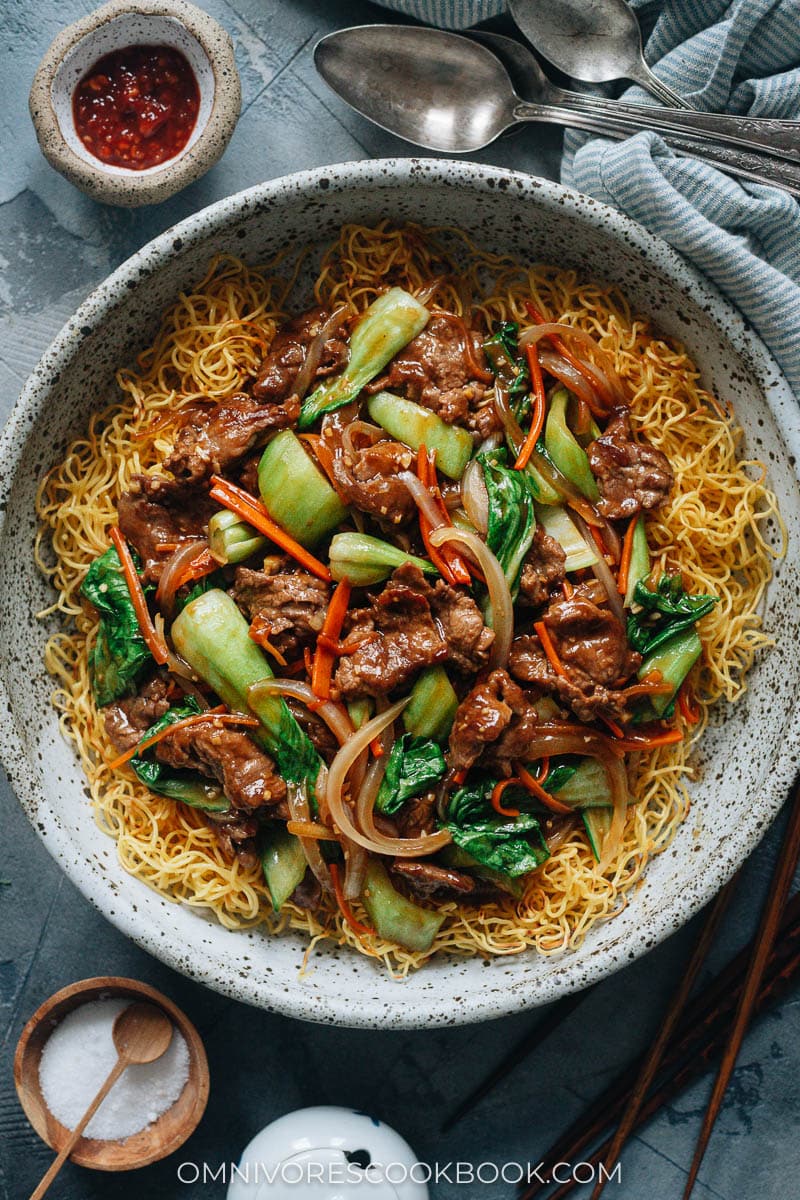
Beef pan fried noodles has always been one of my favorite dishes in Chinese restaurants. Those crunchy-fried noodles with the crispy texture. That heavenly brown sauce over the tender slices of beef, all mingling with a bed of crispy noodles and a medley of crunchy veggies. It’s a perfect meal that has everything you need to fill you up and satisfy your Chinese Noodle recipes craving.
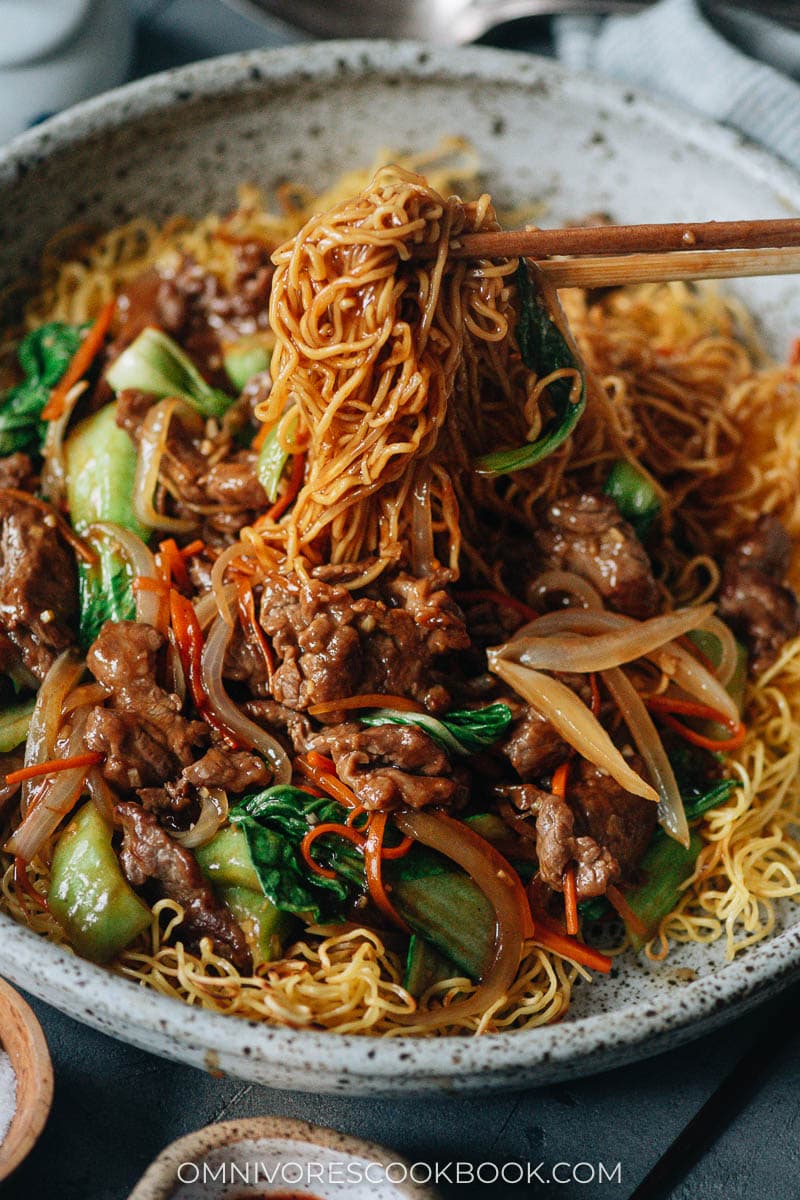
Beef pan fried noodle ingredients
The recipe might look long, but I promise it is incredibly easy to cook. As with any recipe, it always helps to get organized first. When you have everything ready to go, it couldn’t be simpler to prepare.
Most of the ingredients on the list are for making that wonderful brown sauce. You’ll see it all come together so quickly. When added together, all the tastes and textures really satisfy!
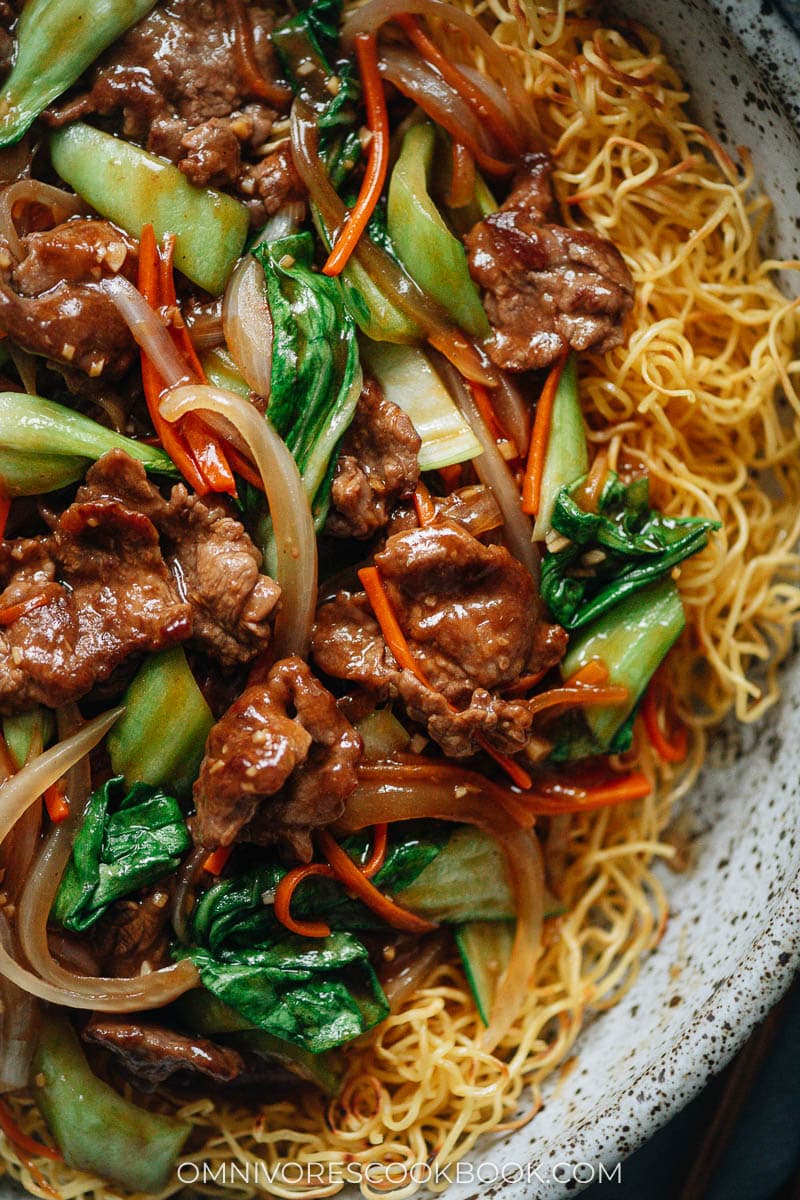
What type of noodles to use
I use Hong Kong pan fry noodles, which are fresh, thin noodles that are partially cooked and ready to use for pan frying without the need to boil them first. It’s the best type of noodles for this dish to create heavenly crispy noodles. You can find them in the refrigerated section of your Asian market, on Weee! or even on Amazon, although they’re very expensive if you buy them online.
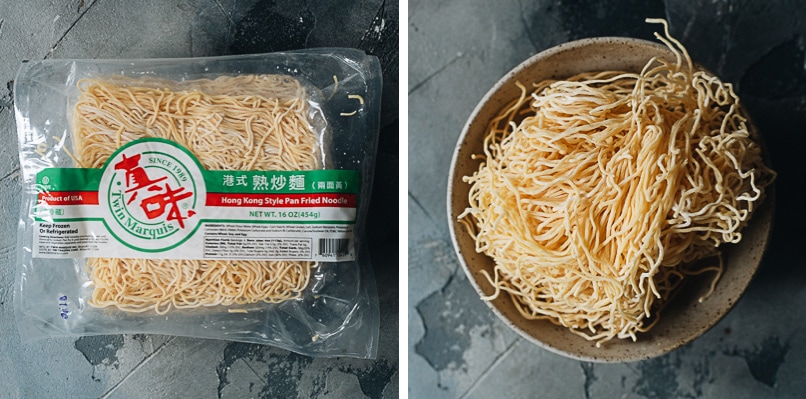
However, you can use other types of thin noodles to recreate this beef pan fried noodles recipe. I have notes further down on simple substitutions that you might already have in your kitchen, though if you can get your hands on the Hong Kong pan fry noodles, I highly recommend them.
What type of beef to use
I like to use beef flank steak or skirt steak for stir fries because they are slightly cheaper than the premium cuts but still produce a tender, juicy result.
Vegetables & aromatics
In my recipe, I use baby bok choy, yellow onion, and carrots, though you can easily customize it with whatever you have in your fridge. Aromatics like ginger and garlic are a must, though, for rendering that authentic flavor that makes you pull out the takeout menu for your favorite Chinese place up the street.
How to cut baby bok choy for stir fry
To create the best evenly cooked texture, here is how I cut baby bok choy:
- Tear apart the larger outer leaves
- Chop the white parts into small bite-sized pieces and leave the green part intact or cut it into bigger bite-sized pieces (depending on the size of the head)
- Keep the small tender leaves whole

When you’re ready to cook, your table should have the prepped ingredients below.
- Hong Kong Pan Fried Noodles
- Marinated beef
- Mixed sauce
- Baby bok choy, sliced
- Aromatics (ginger and garlic)
- Sliced vegetables (onion, carrot)
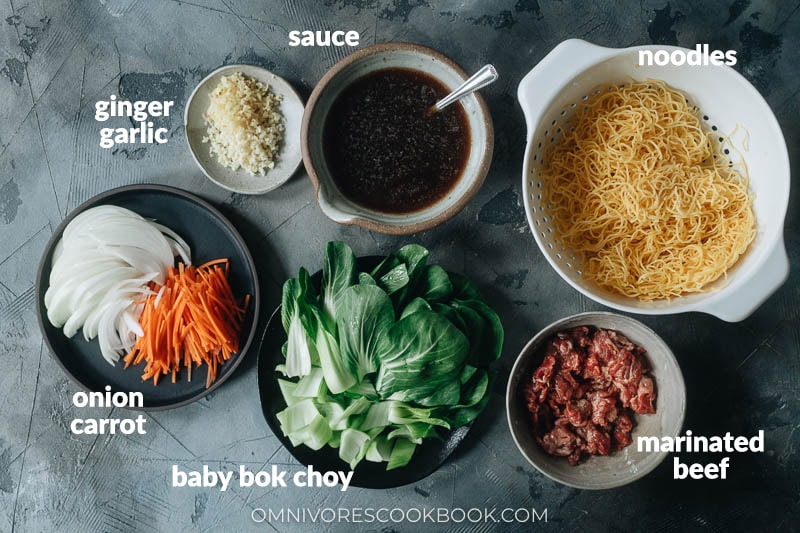
How to cook beef pan fried noodles
To cook beef pan fried noodles:
- Use a generous amount of oil to pan fry the noodles until crispy and move them to a serving plate
- Sear the beef and move it to a plate
- Saute the aromatics and veggies that take longer to cook
- Add the baby bok choy
- Pour in the sauce and cook until it thickens
- Add back the beef and mix. Pour the sauce and beef over the crispy noodles
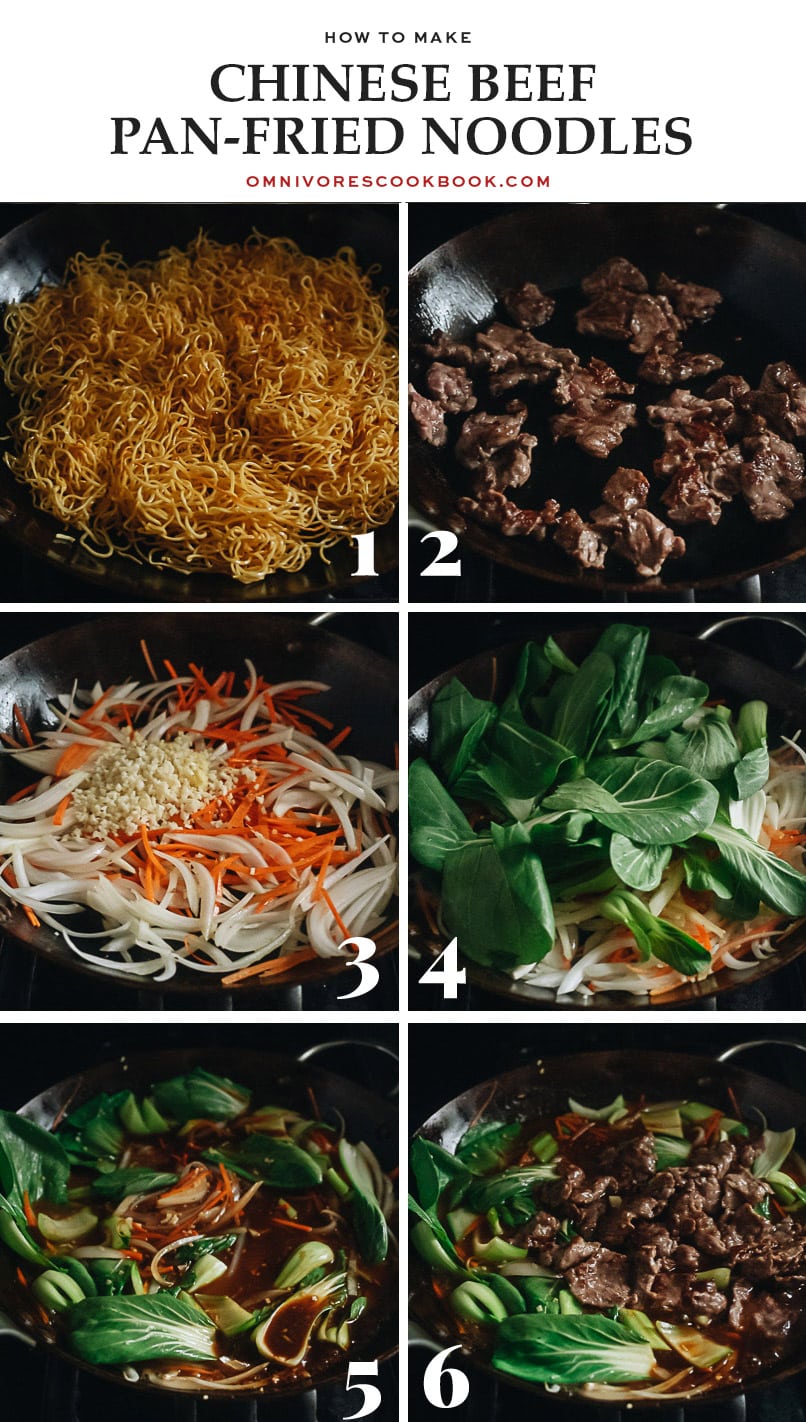

With beef pan fried noodles, you can have dinner on the table well before any delivery would arrive. Even with marinating the beef, which is what gives it that melt-in-your-mouth texture. It all comes together in record time and is sure to be something you’ll make often from now on!
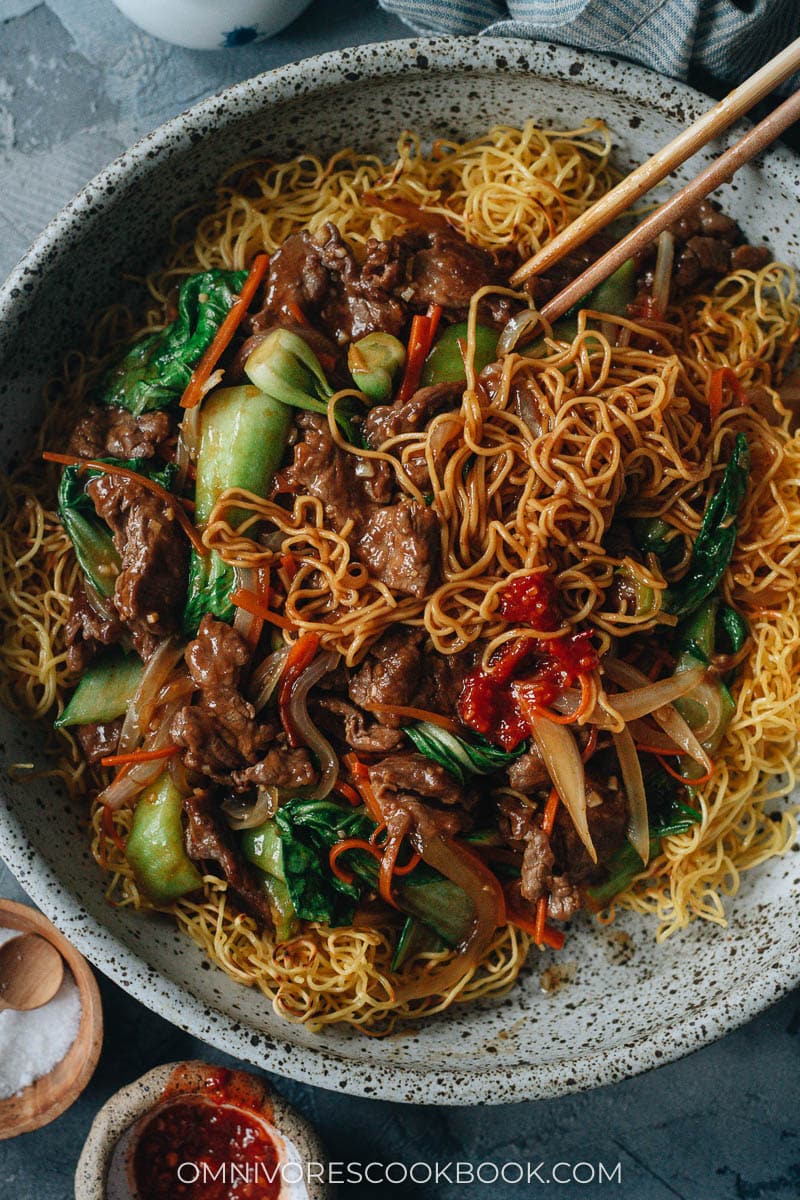
More Chinese takeout recipes
- Chinese Curry Chicken
- Walnut Shrimp
- Beef Lo Mein
- Chicken Fried Rice (鸡肉炒饭)
- Easy Mongolian Meatballs
- General Tso’s Chicken (Crispy Chicken Without Deep-Frying)
- Broccoli and Mushroom Stir Fry
Chinese Cooking Made Easy
Are you new to this website? This free email series is a great place to start. I’ll walk you through a few of my most popular recipes and show you how and why they work. You’ll quickly start to cook better Chinese food in your own kitchen.
Watch video
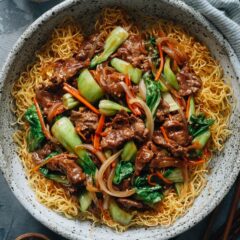
Beef Pan-Fried Noodles
Ingredients
- 8 oz flank steak (or skirt steak) , thinly sliced against the grain
- 8 oz fresh Hong Kong pan fry noodles (or other type of thin noodles) (Footnote 1)
Meat & Marinade
- 2 tablespoons Shaoxing wine (or dry sherry)
- 2 teaspoons cornstarch
- 1/4 teaspoon salt
Sauce
- 1 cup low-sodium beef broth
- 2 tablespoons soy sauce (*Footnote 2)
- 2 tablespoons oyster sauce
- 1 tablespoon Shaoxing wine (or dry sherry)
- 2 tablespoons cornstarch
- 1 teaspoon sugar
- 1/4 teaspoon Chinkiang vinegar
- 1/4 teaspoon white pepper
Stir-Fry
- 4 tablespoons peanut oil , divided
- 4 heads baby bok choy , quartered
- 4 cloves garlic , minced
- 1 " ginger , minced
- 1/2 yellow onion , sliced
- 1/2 carrot , sliced into strips
Instructions
- Combine the beef and the marinade ingredients in a medium-sized bowl. Toss with your hands to coat the beef evenly and let marinate while preparing other ingredients.
- Combine the sauce ingredients in a medium-sized bowl and stir to mix thoroughly.
- Prepare the noodles according to package directions (*Footnote 3). Drain and set aside in a colander to dry.
- Heat a large heavy-bottomed pan (nonstick or carbon steel) with 2 tablespoons of peanut oil over medium-high heat until hot. Spread the noodles into a patty shape (*Footnote 4). Cook without flipping until the bottoms turn golden. Turn the noodles to fry the other side until golden. Drizzle in a bit more oil to help with the frying, if needed. Once done, transfer the noodles to a big serving plate.
- Pour 1 tablespoon of oil into the same pan. Add the beef and spread it out in a single layer using a pair of tongs or chopsticks. Let cook undisturbed for 30 seconds or so, or until the bottom turns golden brown. Flip to cook the other side until browned. Stir a few times until the beef is cooked (it’s OK if there’s a hint of pink inside), transfer to a big plate, and set aside.
- Add the remaining 1 tablespoon of oil to the pan. Add the onion and carrots. Quickly stir a few times to mix well. Add the ginger and garlic. Stir and cook for 30 seconds to release the fragrance.
- Add the bok choy. Cook and stir for another minute, until the veggies start to soften.
- Stir the sauce thoroughly to dissolve the cornstarch completely and pour the sauce into the pan. Stir and cook to bring the sauce to a boil, and cook until it starts to thicken.
- Add the cooked beef back into the pan. Stir to mix everything well. Once the sauce reaches the desired consistency, pour everything over the fried noodles. (*Footnote 5)
- Serve immediately as a main dish.
Notes
- Hong Kong noodles will yield the best texture. The best alternative is vermicelli pasta, which yields a similar result. If you can’t find either, you can also use ramen noodles (a bit thicker) or angel hair pasta (a bit thinner).
- If you wish to add the dark brown color to your noodles (as shown in the photos), replace 1 teaspoon of soy sauce with dark soy sauce. It won’t affect the taste either way.
- Hong Kong noodles can have different preparation methods depending on the brand. Some don’t require boiling and you can directly pan fry them. In such a case, you might need to pour in a small cup of water (1/4 cup or so) to steam the noodles in the frying pan so they are not too dry. If the package requires boiling but doesn’t indicate a time, you should boil the noodles and keep a close eye on them so they will be al dente. I briefly cooked mine for under 1 minute. If you use pasta, cook it until al dente. If you use thin Asian noodles, cook them 1 minute less than the package indicates.
- This recipe yields a big plate of noodles to share. If you wish to cook individual servings, you can fry the noodles in 2 to 3 batches to create smaller plates.
- If you do not plan to serve the dish immediately, transfer the sauce into a big bowl and cover it to keep warm. Pour the sauce over the noodles right before serving so the noodles remain crispy.
Nutrition

Did you make this recipe?
I’d love to hear how it turned out for you! Please take a moment to leave a 5-star rating ⭐️ and share your thoughts in the comments further down the page. It really helps others discover the recipe too.
If you give this recipe a try, let us know! Leave a comment, rate it (once you’ve tried it), and take a picture and tag it @omnivorescookbook on Instagram! I’d love to see what you come up with.
More Chinese restaurant style recipes
Lilja Walter is a part of the Omnivore’s Cookbook team and worked closely with Maggie to develop and test this recipe.

Cc
This recipe is SO GOOD. Creamy, crunchy, perfect. I used ramen noodles and they fried perfectly. Cabbage instead of bok choy was pretty great too. Definitely will make again!
Joanne C
Is this supposed to be Liang Mian Huang? Just checking before I tried – it looks good either way sometimes knowing what it is/is not supposed to be helps me temper my expectations (otherwise I might get disappointed if it tastes different from how I hoped).
Gordon White
I loved how all the ingredients came together. My picky girlfried dared tried it then cooked more noodle up. Iam a hunter so i used deer tenderlion and was great.
Mary
Is this the same as Cantonese Chow Mein?
Maggie Zhu
They are different. The noodles in this recipe is pan fried until very crispy, and the sauce is poured over.
The Cantonese chow mein noodles are softer, and the sauce is added to the pan to mix in before serving.
andy palley
The best Chinese restaurants in Flushing and elsewhere around NYC make pan-fried noodles, and this recipe can absolutely get you there. It’s the best recipe for pan-fried noodles I’ve found.
Susan F.
Ohmygosh! I love trying out new recipes, but they don’t always turn out as flavorful as I want. This recipe is WONDERFUL! Explicit directions and not hard to find ingredients. Hubby and I though very tasty! Will make again!
Stan H
I tried this recipe last week and it was a real winner! My one (small) challenge was trying to brown the noodles without burning them. That will take some trial-and-error. Will definitely make this dish again soon!
Xin Nian Kuai Le!!
Ellen
Can I use chicken instead of beef? Any changes in the ingredients
Maggie Zhu
Yes you totally can! No need to change other ingredients.
Saira
This looks so good! I prefer soft noodles to crispy ones, is there a way to modify the recipe to get that result? The veggies, beef and sauce look perfect for what flavours I want so I don’t know if I’d just have to choose a different kind of noodle or simply not cook them until crispy.
Thanks!
Maggie Zhu
Hi Saira, you can simply cook the same type of noodles briefly with less oil so they stay soft. You can also use different type of noodles, such as lo mein or chow mein noodles as well. The sauce is super flavorful and you can even top them on boiled noodles directly.
Mr Larry Hamilton
Hi Maggie,
Love, love loved this dish. Love to cook but I must admit, I’m very intimidated when it comes to asian cooking. Even though it’s my favorite cuisine. So many different cultures and regions and each one is unique and distinct. Seems overwhelming with ingredients. Especially the noodles. Either I can’t find the right ones at my 2 local asian stores or I have to order them. Thank you for providing links of most products. Honestly, I wish that I could just help you cook and then enjoy.
Ashley B
This was incredible! I followed the recipe as much as I could but I had to substitute Mirin for the Shaoxing wine (so I left out the sugar later) and I subbed Rice vinegar + soy sauce for the Chinkiang vinegar. I also forgot I ran out of fresh ginger so I had to use ground ginger; I’ll use fresh ginger next time, but it still turned out delicious. I’ll definitely be making this again!!
Maggie
Glad to hear you like the dish Ashley! You’re very resourceful and it’s great that the replacement worked out 🙂
Lauren
Oh this looks so good!!! Can you use flat iron steak instead of flank or skirt steak?
Maggie
Yeah you totally can!
Jen
This recipe was AMAZING, Maggie! Delicious!!! I found the HK style noodles at my local 99 Ranch grocery store and you were right, they taste great. I was afraid of pan frying the noodles at home, as I have a very sensitive smoke alarm, but it all turned out perfect by using more a medium heat (took longer, but the noodles crisped up great!). Excited about leftovers today and making this again in the future. Next time, I want to try seafood style instead of beef. YUM, thank you!
Maggie
So happy to hear you like the recipe Jen! Yes, the HK style noodles are the best for this type of dish. So easy to use and taste great. Glad you can find it locally 🙂
Marlena
So delicious and easy to follow recipe. When looking for the noodles I was searching in the dried noodle section of H Mart but found them in the fresh noodle section. So make sure you check the fresh noodle section first! I will definitely be making this again. Used my large cast iron to cook everything (except for the noodles). Cooked really well.
I added red bell pepper to the veggies which was a great addition to the mix.
Thanks for sharing this recipe! Can’t wait to make it again
Caroline Shepard
So delicious! My family gobbled it down and wanted more. I had to use chicken broth and rice vinegar, but still came out great. The crunchy noodles were key. Do you have any thoughts on preparing steak so it steams less, and crisps a little better? Thanks, again for a fabulous meal.
Sashi
Hey Maggie, simply put, you’ve done it again! This one was delicious. We enjoyed it with some shiitake mushrooms (because they came with the pak choi. Not sure the portion sizes can survive four people, we did it for three and there is a little left! Thanks so much for this amazing addition. We will make it one of the faves alongside real deal beef schezuan. Brilliant!
SHARON
Can you use thin rice noodles as an alternative in this dish? I’m gluten intolerant.
Maggie
Hi Sharon, yeah you can use rice noodles. They will produce a different texture once fried but if you drain them well and fry with plenty of oil, they should turn out crispy as well.
NJ
Hi ! Is there any suitable substitute for Chinkiang vinegar?
Thx!
Maggie
Rice vinegar or distilled vinegar will work. Happy cooking!
mare
Excellent. Made it last night and finished it for breakfast!
Bill Zigrang
Maggie,
?Is this a version of e-fu (or yee-fu) (or longevity) noodles??
Maggie
I’m afraid it’s not the same version. The y-fu version use different noodles and the cooking method is different too (boil noodle and cook with the sauce And this one is to fry the noodles until crispy, then pour sauce on top).